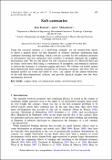Soft catenaries
Author(s)
Kamrin, Kenneth N.; Mahadevan, L.
DownloadKamrin_Soft catenaries.pdf (607.4Kb)
PUBLISHER_POLICY
Publisher Policy
Article is made available in accordance with the publisher's policy and may be subject to US copyright law. Please refer to the publisher's site for terms of use.
Terms of use
Metadata
Show full item recordAbstract
Using the classical catenary as a motivating example, we use slender-body theory to derive a general theory for thin filaments of arbitrary rheology undergoing large combined stretching and bending, which correctly accounts for the nonlinear geometry of deformation and uses integrated state variables to properly represent the complete deformation state. We test the theory for soft catenaries made of a Maxwell fluid and an elastic yield-stress fluid using a combination of asymptotic and numerical analyses to analyse the dynamics of transient sagging and arrest. We validate our results against three-dimensional finite element simulations of drooping catenaries, and show that our minimal models are easier and faster to solve, can capture all the salient behaviours of the full three-dimensional solution, and provide physical insights into the basic mechanisms involved.
Date issued
2011-12Department
Massachusetts Institute of Technology. Department of Mechanical EngineeringJournal
Journal of Fluid Mechanics
Publisher
Cambridge University Press
Citation
Kamrin, Ken, and L. Mahadevan. “Soft Catenaries.” Journal of Fluid Mechanics 691 (2011): 165–177. ©Cambridge University Press 2011
Version: Final published version
ISSN
0022-1120
1469-7645